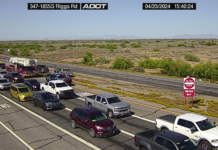
Water bills in Maricopa can cause powerful reactions, but the August bill for a Senita couple actually brought on an asthma attack.
Walter Mrozowski and Corrine Tabarez were charged $1,930.39.
Mrozowski called it “a shocker.” It literally took Tabarez’s breath away.
Their previous bill was $132.70.
“We have no intention of paying it,” Mrozowski said. “The water and sewage fees in Maricopa are abysmal, but the thing that really gets me the most is that whatever program they use did not red-flag that.”
The bill indicated the couple used 305,022 gallons in one month. That is six times the size of an average residential swimming pool.
Mrozowski and Tabarez have not installed a swimming pool, nor have they planted an orchard.
Their meter reading at the end of July was 1,038,119. The meter reading shown on the bill for Sept. 1 was 1,343,141. The actual number on the meter on Sept. 21 was 1,048,860.

The 300,000-gallon over-read is an anomaly, as far as Global Water General Manger Jon Corwin is concerned.
“The most common meter-related issue we see is the measuring chamber stops spinning or spins slowly, recording lower consumption than is actually passing through the meter,” he said. “Meters almost exclusively fail by under-registering water, meaning customers are charged for less water than they actually use.”
Because their bill arrived on a weekend, the couple did not know how to reach anyone at Global Water. The stress brought on her asthma. Tabarez reached a staff member the following Monday, Sept. 14.
“She said they would not charge me to send someone out to read the meter since they were not getting daily readings from the meter,” Tabarez said.
Corwin said Global Water will “typically respond to a customer field investigation within three to five business days if not sooner.”
At 2:30 p.m. Sept. 18, Tabarez received a call from a Client Services representative, who apologized and told her they would be getting a new bill.
Tabarez said she was told Global Water sent a technician to read the meter because the transmitter was broken. When Tabarez said it did not appear anyone had read the meter in a while because it was caked with mud, she was told that happens after a rain.
But Mrozowski said modern technology should have prevented such an error and at least have indicated a problem with the meter.
“If it’s not being transmitted, how do I know my usage of 12,000 gallons shouldn’t have been 6,000?” he asked. “I have no way of knowing if it’s accurate.”
According to Corwin, the basic function of a meter is:
1. Water passes through a measuring chamber within the meter
2. The chamber spins an attached magnet, which translates into a reading on the meter register dials
3. The end point transmits the meter read to Global Water
“In Maricopa, each meter has what is called an end point, which is a device that transmits the meter read to Global Water and eliminates the need for a technician to go out and manually obtain a meter reading,” Corwin said. “On occasion the end point can fail, which does not affect the meter read, but does require a technician to obtain a manual read.”
Customers who get an anomalous reading can call Global Water and have a technician sent out for a physical re-read, Corwin said.
“We see a lot of instances where high consumption is driven by a leak in the irrigation system, a water softener that gets stuck backwashing or toilets that continuously run,” he said.
A mis-read, rather than a leak, is the suspect in the Mrozowski case.
“If the original meter read was inaccurate, we correct the bill,” Corwin said. “If the original read is accurate, the customer is subject to a $30 fee which the Arizona Corporation Commission approved to cover the labor, fuel and vehicle wear and tear to obtain the additional read.”
Mrozowski and Tabarez question the accuracy of any readings. Tabarez said she was told in her Sept. 18 conversation with Global Water “many of the meters” in Maricopa are broken and the company is replacing them. “Otherwise they have been making estimates for water usage and coming out and reading the meter every few months.”
Corwin said the claim that many meters are broken is inaccurate. And Global Water tries to keep estimates at a minimum.
“We prefer to never estimate a read but on rare occasion we have to estimate a meter reading because the read was not transmitted and we are not able to make the repairs prior to the next read date,” he said. “Some examples we’ve seen in the past where estimated reads were required include vehicles parked on the meter box, plant overgrowth, heavy objects placed on the meter box, etc. If we have to estimate a read, which is allowed per regulations, we follow a very prescriptive process.”

Mrozowski called the experience a wake-up call. He said he wonders how many other Maricopans are affected without knowing their meter readings could be inaccurate. He would also like the company to be more proactive in detecting serious anomalies, like 300,000 gallons of water.
“What’s really amazing is that in the year 2015 with the level of computer technology, Global Water’s computer programs could not flag such an obvious blip for human intervention,” he said. “Just send out the bill and make the customer’s weekend really enjoyable.”








![Who’s the Best Mom InMaricopa? Nominate now! Marlene Marshall, Christina Olivares, and Meghan Bremer. [Bryan Mordt]](https://www.inmaricopa.com/wp-content/uploads/2023/05/BCM_8465-218x150.jpg)





![Alleged car thief released without charges Phoenix police stop a stolen vehicle on April 20, 2024. [Facebook]](https://www.inmaricopa.com/wp-content/uploads/2024/04/IMG_5040-218x150.jpg)



